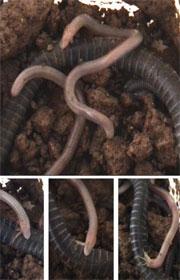 When the kids get hungry they just snack on mom.Credit: NHM and Alexander Kupfer
When the kids get hungry they just snack on mom.Credit: NHM and Alexander KupferHow far would you go to feed your kids? Mothers of some worm-like amphibians called caecilians literally give a piece of themselves, by allowing their young to eat their flesh.
The mothers of Boulengerula taitanus create a nutrient-rich fatty outer layer of skin after laying their eggs. When their offspring hatch, the babies scrape this layer off with specialized teeth.
"It's quite an amazing thing to observe," says biologist Mark Wilkinson of the Natural History Museum in London, lead author of an article describing the phenomenon in Nature this week1.
Wilkinson's group noticed the skin-eating behaviour in Kenya, after seeing that amphibian mothers are often a paler and milkier shade of blue than other females. They had also noticed that young amphibians are born with their own set of teeth.
The researchers brought the burrowing animal into the lab to investigate, videoing 21 mothers with broods of between two and nine young. In the week after their babies hatched, mothers lost about one-seventh of their bodyweight - which showed up as skin cells in the stomachs of young.
Eat me
The only other caecilians known to be born with teeth develop inside a womb, and eat the inside of their mother's oviduct before birth - a trick reported in Nature fifty years ago2.
Other amphibians, such as frogs and salamanders sometimes eat their own skin after it has shed, to recycle nutrients. This newly observed behaviour is similar to that, says Wilkinson, except the babies join in the shedding process.
ADVERTISEMENT
As to why the mothers let themselves be flayed, Wilkinson suggests that making a fatty layer of skin may be cheaper for the mother than giving her eggs a large yolk. And if a baby dies, he notes, the mother's investment in the egg is wasted - but she might be able to save her skin and use it again.
No one yet knows what is in this fatty layer, or how the young know when to stop eating their mothers' skin to avoid killing her. Wilkinson will leave these questions to others; he plans to look for more amphibians that show the same behaviour.
"It's a weird and wonderful thing," says Wilkinson, "It raises more questions than it answers."
Visit our wormsfeedyoungthe.html">newsblog to read and post comments about this story.
